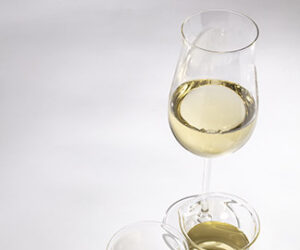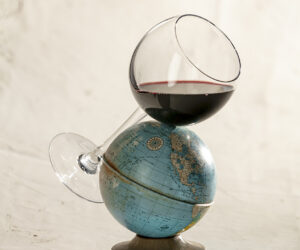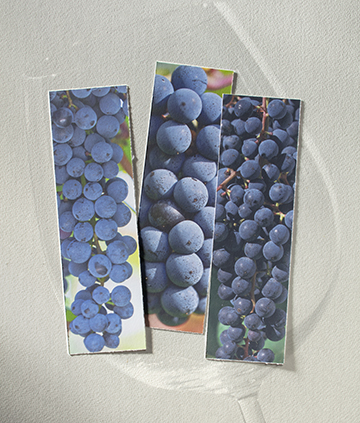
We live in a dichotomous world. Our brains often learn and understand via drawing comparisons and relationships from object-to-object, or from concept-to-concept: Good vs. evil, hot vs. cold, acidic vs. alkaline, bitter vs. sweet, etc. It seems a mental “line in the sand” was drawn between Vitis vinifera grapes and their relatives the French-American hybrids at some point in modern winemaking. French-American hybrids are often less reputed for their winemaking potential due to being higher in acid and lower in tannin content than their cousins in the vinifera species. While they do not have the long-standing winemaking history of the vinifera varieties and more “classic” flavor traits, they have slowly gained popularity amongst many home and professional winemakers.
For the home viticulturist in North America, hybrids offer better disease-resistance, greater cold-tolerance, and higher yields, which are necessary in most of the microclimates of North America. As academic research and hands-on experience lends more data for study of the French-American hybrid varieties, their translation into wine is better understood, therefore improving its quality.
But while the overall quality of hybrid winemaking continues to improve, why is there still such an opposition and perceived quality distinction between the two families of grapes? While Frontenac may never gain the respect of sommeliers, perhaps it and other hybrids will find their niche in the winemaking world as complements to their
vinifera counterparts.
Most winemakers who are familiar with both vinifera and hybrid winegrapes will understand the following generalized characteristics of the grapes. Vitis vinifera, specifically red varieties, are generally lower in acid, higher in Brix, and have higher perceived tannin content upon vinification. Vitis vinifera are the genera of what we have come to know as classic European winemaking grapes, such as Syrah, Cabernet Sauvignon, Merlot, Chardonnay, etc. Whereas hybrids are traditionally deemed as opposite in their traits: High in acids, lower in Brix depending upon growing zones, and lower perceived tannin content upon vinification. French-American hybrid varieties are a new family of grapes that have been derived via cross breeding Vitis vinifera with Vitis riparia, designed specifically to withstand colder growing temperatures of northern North America and to have higher disease tolerance against mildews and molds. These grapes were developed by viticulturists, many at the University of Minnesota and Cornell University, to have strong cold-tolerances in the winter and to have faster ripening to fit with shorter summers and growing seasons. Due to the development of these grapes, it is now possible to grow winemaking grapes successfully in every state in the U.S. While these newer varieties are lesser known than their vinifera counterparts, they are creating their own niche within winery communities in non-traditional growing areas. The hybrid varieties differ in flavor and physical composition than their vinifera cousins.
This author poses the theory that rather than viewing the two families of grapes as adversely different, perhaps they are natural complements of one another? From the periphery, one seems to carry what the other lacks in chemical composition and perhaps flavor profile, depending on the goal of the winemaker. We will probe the different ways the grape families may complement each other in winemaking; the when, why, and how of blending them.
From professional farmer to home gardener and viticulturist, one understands that not every year can be a benchmark for yield and quality. For those of us in the Northern third of the U.S., French-American hybrids are the crop of choice to best work within our microclimates. When the produce rolls in from the fields, a winemaker is quick to process and analyze the grape must to gain the metrics of what they are working with. Oftentimes our grapes, both vinifera and hybrid alike, will require adjustments in acidity and sugar content before fermentation begins. Nature varies with growing seasons and our grape acid, phenolic, and sugar content will vary from year-to-year and require the winemaker’s intervention to create optimum fermentation conditions. A common problem amongst viticulturists in non-traditional North American growing regions is lack of proper ripening conditions. Harvest time will approach and the sugar content will be too low and the acid content much too high. While the obvious choice would be to chaptalize the must and increase the fermentable sugar content and then reduce the acidity via potassium bicarbonate or calcium carbonate, this does not account for the phenolic development of the grapes. The rich flavors of cherry, bramble fruits, and earth in a properly ripened Marquette could manifest more as sour cherry and green vegetables in under-ripe Marquette fruit. Sourcing fruit to help ameliorate some of the green notes as well as add ripened phenolic character may be necessary to help balance the wine and contribute to its flavors post fermentation. The aforementioned traditional means of chaptalization via sucrose and acidity reduction via an alkaline source will still be necessary to amend the entire batch once the riper vinifera have been combined, but the addition of the vinifera grapes can make up for lacking phenolics.
As a growing season progresses, a grape grower will see the “writing on the wall” for that vintage of grapes. If weather trends have been poor, without good ripening conditions, they may want to consider blending their fruit with some commercially sourced fruit.
A winemaker must choose a complementary grape variety for the blend at crush. Staying with the example of under-ripe Marquette, if the winemaker is choosing to increase phenolics and add flavor, they must consider a few things: The typical characteristics of the hybrid, the typical characteristics of the vinifera, and the end goal flavor profile of the wine. Within the genetic lineage of Marquette lies Pinot Noir, contributing its rich bramble fruit flavors and softer mouthfeel. This vinifera variety would be a natural complement to Marquette. Working with a reputable grape vendor, the winemaker can get a recommendation for a Pinot Noir from a growing region that develops excellent phenolic ripeness. By the addition of these grapes to the crush, the wine’s phenolic potential will increase and some of the green characters will be reduced. In this particular example, I would recommend sourcing a yeast strain that also is known for reducing green and vegetal characters to help overcome this negative character such as Scott Lab’s CLOS or CSM strains.
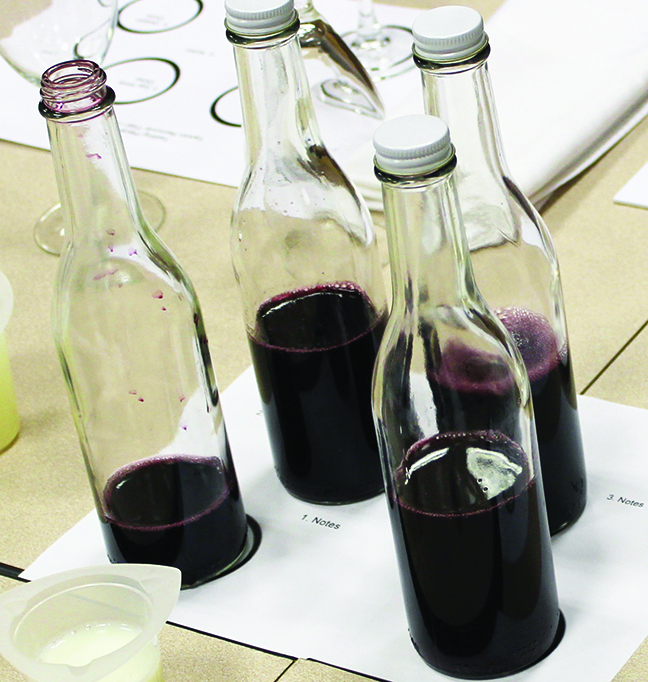
This benefit of blending vinifera and hybrid grapes can work the other way too. When working with some white vinifera varietal juices from California and other warm growing regions, the grapes can achieve high ripeness and lower acid levels in hot years. A natural way to increase the acidity could be to add a percentage of juice from white hybrid grapes. In European winemaking, a small amount of white grapes are sometimes used to add acid in red vinifera grapes that lack it such as the Grenache Blanc in Chatenuef du Pape blends.
If you live outside of a major growing region such as the West Coast, visiting local wineries in your area is a great way to get to know the hybrid white varieties and their winemakers. Perhaps helping to harvest some local grapes may get you an opportunity as a winemaker to purchase some to add acidity and complexity to your own blend. To gain insight into the volume of grapes you would need to ameliorate the acidity of your primary varietal you need to know the titratable acidity. Using this value in the Pearson square mathematical equation can give the winemaker the ratio of grapes needed to achieve the desired titratable acidity. (Learn more about the Pearson square at
https://winemakermag.com/article/the-pearson-square and there are also online calculators that can help compute the values.) The resulting overall batch size should be a consideration when choosing the blending path of amelioration.
Natural Complements
There are a myriad of reasons why a winemaker may choose to blend at crush, the most typical two being to help one variety compensate for what another lacks, or for the varieties to complement each other well and increase the complexity and richness of the wine. While the previous two examples have addressed the former reason of naturally compensating for a primary varietal that lacks a key component of wine balance, now we will examine co-fermenting and blending wines that naturally complement one another. Many interesting wines could be formed through the blending of vinifera and hybrid varieties that share similar characteristics. A rich, peppery Syrah with a touch of Marechal Foch could add an interesting earthy flavor to the spice and black fruit of the Syrah. A small introduction of Traminette into a Riesing could add a subtle floral flavor element and increase aroma complexity. A small portion of Frontenac or Sabrevois can add rich color and fresh fruit to the jammy ripeness of a Zinfandel.
The sky is the limit on the possibilities of blending. When to blend really becomes the more important technical question. The idea of the blend is the artistic component; the decision on when to blend, the scientific one.
While the previous discussion has mentioned blending at the point of crush and onset of fermentation, this may not always be the most appropriate timing depending on the desired goal of the winemaker. Due to their varying physical and chemical properties, the two varying families of grapes may have varying reactions when blended, particularly red cultivars. Red French-American hybrids have a significantly higher amount of protein than vinifera varieties. While they have an unfortunate stereotype of lacking in tannin in the finished product, this is not the case of their pre-fermentation physical composition. French-American hybrids do have high amounts of tannins, with some varieties even being comparable to their Vitis vinifera counterparts. Due to the high levels of protein, these natural grape tannins bind with the proteins during the heat of fermentation and can precipitate out, leaving the resulting wine lacking in tannic structure. For this reason, adding in a vinifera at the time of crush to increase the end resulting structure may be futile as the high proteins will bind to the vinifera tannins, lessening their impact. Instead, if the winemaker were to ferment the varietals separately and blend post-fermentation once stability has been achieved, this may prove to be a more rewarding method. When the wines have had some time to degas, complete malolactic fermentation (MLF), maintain some SO2 binding stability, and are cold stable, they may be a much better candidate for blending. The addition of a vinifera variety to increase the tannin content of a hybrid wine blend would be more appropriate post-fermentation. The tannins would have a greater impact and less opportunity to bind with the proteins within the hybrid variety. The addition of the vinifera to the hybrid may provide the tannic structure in both the mid palate and finish that hybrids can sometimes lack.
Also at this point of stability and aging, the winemaker may see a greater organoleptic effect of a small addition of a hybrid to a vinifera to increase acidity and fresh fruit quality and balance tannic intensity. A very small addition of hybrid grapes can have their strong, bright fruit flavor profile show through, even with as little as a 5% addition to the primary variety. In bench trials, I have observed a noticeable aroma change with as little as a 3% hybrid varietal addition and a pronounced flavor profile change with a 5% addition. If the winemaker has access to hybrid varieties, whether they be homegrown or purchased from a local vineyard, these varieties may lend unique fruit character and natural acidity to purchased grapes or kits comprised of vinifera.
What about white blends?
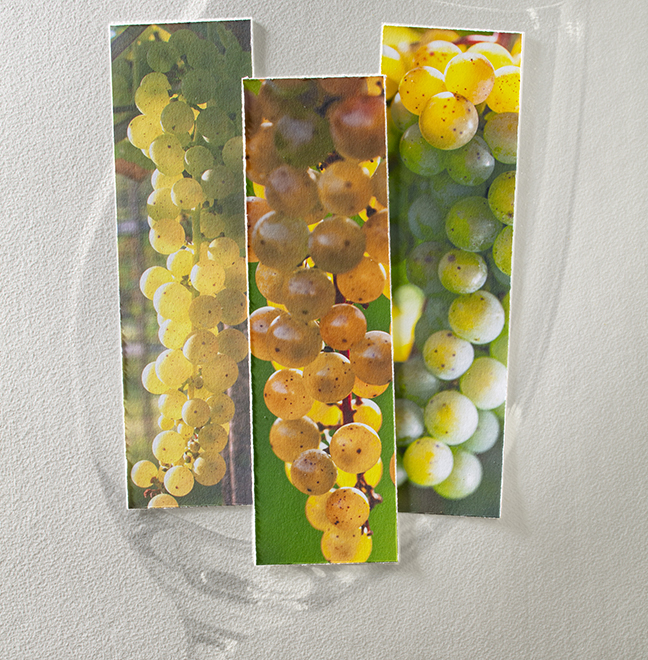
While the mainstay of examples has been red varieties in blending, white varieties would also pose some interesting possibilities for blending. White French-American hybrids often have bold fruit flavors that can bring a very unique flavor to a blended wine. Again, the winemaker must consider the end goal flavor profile of the wine and the base wine that they are working with. Is it a hybrid that needs to be slightly less acidic or needs more sugar pre-fermentation? Or is it a vinifera variety that needs a little added boost of acidity or a particular flavor profile? These are all questions to be considered before the blend. Similar to the reds, if the winemaker’s homegrown crop is lacking in either sugar content or phenolic development due to a poor growing season, the addition of some commercially grown vinifera may help the base hybrid wine along on its path. This blend would be conducted at crush and co-fermented, in hopes of a natural chaptalization of the sugar and phenolic content. Other chemical inputs may be needed such as white fermentation tannins and an alkaline addition to reduce the acidity.
The same stability factors of blending any white wines will come into play if blending hybrid and vinifera grapes post-fermentation. All wines should be fined for heat/protein stability after blending. A protein-rich hybrid can greatly affect the heat stability factor of a less proteinaceous vinifera variety. While some vinifera may only require less than a gram of bentonite per gallon (4 L) to achieve stability, bench trials should always be conducted after blending to ensure the new blend is stable. Cold stability is also an incredibly important factor. Hybrid grapes naturally hold much higher levels of tartaric acid. This acid will easily precipitate out with exposure to cold temperatures. If a small amount of a hybrid variety is used to enhance the aroma of a lacking vinifera wine then post blending cold and heat stability trials should be conducted, even if both wines are deemed as stable prior to blending.
While these factors may seem precarious in terms of stability to the resulting wine, the value of a white hybrid to a blend should not be overlooked. A nice, bright pop of pineapple from La Crescent to a Viognier may enhance the Viognier’s natural tropical attributes. Tart Granny Smith apple characters from a Seyval Blanc could enhance a Chardonnay that has undergone MLF and may be too buttery. A bit of Traminette or Vidal Blanc could add complexity and aromatics to a Riesling in a vintage that the winemaker finds lacking. The blending can be seen as complementary or reparative, depending on the winemaker’s view of the original base wine.
There are a myriad of examples and potential combinations as well as motivations that come to mind when thinking of potential blending candidates of hybrid and vinifera varieties. Rather than viewing the grapes as Old World vs. New World, perhaps focus on the similarities and nuances of the varieties. Getting to know your hybrid grapes may prove useful when trying to grow within your own microclimate and also when amending wines within your cellar. Their higher yields and dynamic flavors can complement a lower yielding vinifera in your home vineyard and can help to bulk up the quantity as well as potential quality of your homemade wines. Understanding what these hybrids’ characteristics are and what their potential contributions could be to a blend will only help your winemaking skills and resulting products.
Recommended White Hybrid/Vinifera Blends
Traminette with Gewürztraminer or Riesling – Traminette has a genetic parent of Gewürztraminer, which gives it its intense floral nose. This would be a great addition to a lackluster Riesling or Gewürztraminer needing an acidic boost.
Seyval Blanc with Sauvignon Blanc – Both grapes have a strong citrus flavor profile and puckering acidity. Some Sauvignon Blanc could help to buffer a low yield year for locally grown Seyval.
Chardonel with Chardonnay – Chardonel’s genetic ancestors are Chardonnay and Seyval Blanc. The hybrid offers more direct citrus notes that could complement a flabby Chardonnay or one that has dominant stone fruit flavor.
Vidal Blanc with Riesling – Vidal Blanc often has flavors of apricot, honey, and pear upon fermentation. This would be a delicious addition to a Riesling, creating a very fruit-forward wine.
Cayuga with Pinot Grigio – When trying to buffer a low yield year or underripe Cayuga, Pinot Grigio brought in from a warm climate can offer similar fruit flavors and a higher sugar content.
Recommended Red Hybrid/Vinifera Blends
Sabrevois with Merlot – Rich flavors of cassis and dried lavender from the Sabrevois, as well as its deep inky pigment, can help to add depth of color and flavor to a Merlot.
Noiret with Syrah – With complementary flavors of black pepper, bramble fruits, and heavier tannin content, these two seemingly different grapes could be a perfect pair.
Frontenac with Cabernet Sauvignon or Zinfandel – Some growing year’s vinifera grapes may have a hot climate, generating jammier, cooked fruit flavors rather than fresh fruit flavors. Frontenac has a rich, dark color and bold fresh fruit flavor; even a small addition could add an excellent fruit- and pigment-enhancing quality.
Chambourcin with Carménère – Carménère, especially when grown in the Southern Hemisphere and young in age, can exhibit a lot of green vegetal character. A post-fermentation addition of some bold Chambourcin can add spicy pepper and intense cherry and cranberry flavor.
Marquette with Pinot Noir – Marquette was genetically derived from Pinot Noir, accounting for its medium body tannin content, cherry flavors, and lighter brick red hue. If homegrown Marquette has a low yield or ripening year, a crush blend with Pinot Noir may help to harmoniously increase the volume.


